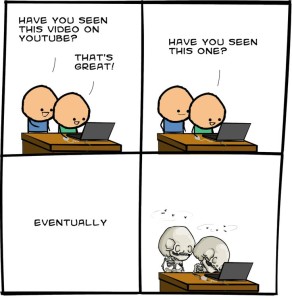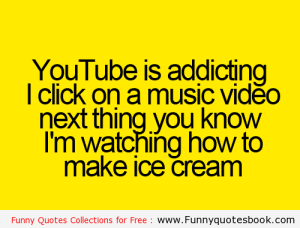YouTube (owned by Google) has come a long way since the idea for the popular video-sharing site was first sparked at a San Francisco dinner party in 2005. The concept was comically inspired by the viral Super Bowl “Janet Jackson wardrobe malfunction” when the three founders, Chad Hurley, Steve Chen, and Jawed Karim (all early employees of PayPal at the time) discussed the difficulty of finding, watching, and sharing video clips of the mishap online. “Video, we felt, really wasn’t being addressed on the Internet” said Hurley in an early interview, “People were collecting video clips on their cell phones…but there was no easy way to share.”
YouTube began humbly as a technology startup, situated just above a pizzeria and Japanese restaurant in San Mateo, California. Its start was mostly thanks to an $11.5 million investment by Sequoia Capital, one of Silicon Valley’s most profitable capital investment firms. As expected, the site grew rapidly within its first year. Just a few months after YouTube began its public beta testing, the site was receiving more than 100 million views and 65,000 new videos each day. Today? Today 100 hours of video are uploaded to YouTube every single minute!
The first ever YouTube video uploaded by founder Jawed Karim, “Me at the zoo”
So where did this beloved website get its name? Let’s find out why YouTube is called YouTube and how YouTube has given “viral” a whole new meaning.
Why is it called YouTube?
The name “YouTube” is actually pretty straightforward. The “You” represents that the content is user generated, created by individual users and not the site itself and “Tube” is a nod toward an older original term for television. Back when TVs were new, pre-LCD display monitors used cathode ray “tubes” to deliver images. Early on in YouTube’s history, however, this caused a few problems. In 2006, another company named Universal Tube & Rollform Equipment, whose website was similarly named www.utube.com, filed a lawsuit against YouTube. The outcome? The company has since changed its name to www.utubeonline.com. Since this early hiccup, the name YouTube has grown proud and strong; the site is now localized in 75 countries and available in 61 languages and hundreds of hours of video are uploaded each minute! Want some more staggering statistics? Visit YouTubes Statistics page here.
See Also: Why is it called Google?
Now, YouTube is a decade old and most of us can’t imagine life without it – some would even argue we would be lost.” What Gutenberg did for writing, online video can now do for face-to-face communication,” said TED curator Chris Anderson in his recent TED Talk on crowd-accelerated innovation. It’s “the biggest learning cycle in human history.” An excellent example of this phenomenon is Khan Academy, a YouTube-based tutoring service that provides free education to more than ten million students through YouTube, completely disrupting the initial concept of how learning might be delivered to the masses. From education to social awareness, journalism to advertising, and even politics to the expansion of celebrity and popular culture, you would be hard-pressed to find a website more influential than YouTube.
When Hurley, Chen, and Karim first sat down at that dinner party, never would they have imagined a world in which the mere mention of the common name “Charlie” would immediately spur the bubbling quote, “Charlie bit me! That really hurt Charlie!” in a delightful British accent. Where would we be without Gangnam Style, Nyan Cat, David After Dentist, Rebecca Black’s Friday…the list goes on and on! Without YouTube, it is unlikely that Justin Bieber would have found fame. Some of us are okay with that.
Half of these YouTube videos have less than 500 views – not much to brag about. But a small percentage of them are able to garner millions and millions of hits, causing even the most obscure individuals to become celebrities overnight. At first glance, viral videos may seem incredibly diverse: a video in which a New York woman recording catcalls to advocate against street harassment, Evolution of Dance where Comedian Judson Laipply demonstrated some of the most popular dance moves through the ages, or Chris Crocker’s tearful rant defending Britney Spears against haters. Millions of people upload videos to the site hoping to catch that ‘one in a million’ shot at being a YouTube celebrity by “manufacturing viral.” What is it exactly that causes something to catch fire so quickly? Here’s what we know:
The answer is emotion, according to Wharton professor Jonah Berger:
“Emotion is a big driver of what goes viral. Whether something pulls on our heartstrings, makes us angry, or provokes controversy, the more we care the more we share.”
This also ties into a need for positive self-expression – when a user shares a video, they are also communicating something about themselves, whether it is their humor, fashion sense, hipster taste, or tech-savvy-ness. Relatability is key and information is the final hook. People have an incredible interest in new information and creativity; any video that appeals to this need to learn and experience new things tends to do well. So what’s the formula?
Emotion + Relatability + Sharability + Novelty = That Video Everyone Knows
Unfortunately, for many of us spotlight-seekers, every viral video also requires a little bit of magic: that silly or heart-wrenching or vastly new thing that makes it stand out from the rest. Think you have what it takes?
Thanks for reading “Why is YouTube Called YouTube?” What is your favorite viral video? Comment below! #whyisyoutubecalledyoutube
Lauren Cosgrove is a freelance writer passionate about branding, global issues, and the world’s little mysteries. A Pacific Northwest native, Lauren can be found hiking the great outdoors, practicing her dance steps, or illustrating children’s books.








this has nothing to do about why YouTube is Called YouTube
Thanks for checking out the site, Elyad!
In the post we describe how the founders of Youtube came up with the brand name. “The name “YouTube” is actually pretty straightforward. The “You” represents that the content is user generated, created by individual users and not the site itself and “Tube” is a nod toward an older original term for television.” You can locate the explanation under the section titled “Why is it called Youtube?”
– Adam